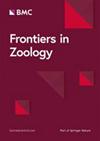蛙鳃吸收带来了什么:功能丧失、细胞死亡和代谢重组
IF 2.6
2区 生物学
Q1 ZOOLOGY
引用次数: 0
摘要
有尾目动物的变态是由甲状腺激素(TH)介导的过程驱动的,它协调了从水生蝌蚪向陆生生命过渡的复杂形态和功能转变,为研究器官功能化、重塑和退化提供了一个宝贵的模型。幼体特异性器官退化是无尾类变质高潮期观察到的最显著现象之一。以往的研究广泛分析了尾部的退化机制,但鳃的吸收分子过程仍然难以捉摸。我们以尾蜥为模型,利用组织学分析、透射电子显微镜和转录组学等综合方法来揭示鳃的发育和吸收。原变态阶段显示了高度发达的鳃结构,强调了其作为蝌蚪主要呼吸器官的关键作用。转录组分析强调了与提高呼吸效率相关的基因(如血红蛋白和粘蛋白)的上调。然而,随着变态的进行,鳃丝发生了收缩、血管密度下降和结构变化,这标志着呼吸功能的下降。驱动鳃吸收的分子机制涉及甲状腺激素途径,特别是甲状腺激素受体(TR)β、肿瘤坏死因子途径相关基因和基质金属蛋白酶的上调。两种不同的途径协调了鳃的吸收,包括由 TH 直接诱导的细胞凋亡和通过细胞外基质降解造成的细胞死亡。此外,变态过程中的新陈代谢重组是一个复杂的过程,蝌蚪会调整其摄食行为并动员能量储存器官。以前被忽视的鳃被揭示为潜在的能量储存器官,会发生新陈代谢重组。转录组分析揭示了新陈代谢相关基因的动态变化,表明在变态高潮期蛋白质合成和能量生产减少,底物运输和新陈代谢增强。这项研究揭示了鱼腥鳃发育和吸收过程中的结构、分子和代谢动态。这些发现加深了我们对器官退化的复杂机制的理解,并强调了鳃在促进从水生栖息地向陆生栖息地过渡过程中的关键作用。本文章由计算机程序翻译,如有差异,请以英文原文为准。
What frog gill resorption brings: loss of function, cell death, and metabolic reorganization
Anuran metamorphosis, which is driven by thyroid hormone (TH)-mediated processes, orchestrates intricate morphological and functional transformations for the transition from aquatic tadpoles to terrestrial life, providing a valuable model for studying organ functionalization, remodeling, and regression. Larva-specific organ regression is one of the most striking phenomena observed during the anuran metamorphic climax. While previous studies extensively analyzed the regression mechanisms of the tail, the molecular processes governing gill resorption remain elusive. We employed Microhyla fissipes as a model, and utilized a comprehensive approach involving histological analysis, transmission electron microscopy, and transcriptomics to unravel gill development and resorption. The pro-metamorphic stages revealed highly developed gill structures, emphasizing their crucial role as the primary respiratory organ for tadpoles. The transcriptomic analysis highlighted the upregulation of genes associated with enhanced respiratory efficiency, such as hemoglobin and mucins. However, as metamorphosis progressed, gill filaments underwent shrinkage, decreases in blood vessel density, and structural changes that signified a decline in respiratory function. The molecular mechanisms driving gill resorption involved the TH pathway—in particular, the upregulation of thyroid hormone receptor (TR) β, genes associated with the tumor necrosis factor pathway and matrix metalloproteinases. Two distinct pathways orchestrate gill resorption, involving apoptosis directly induced by TH and cell death through the degradation of the extracellular matrix. In addition, metabolic reorganization during metamorphosis is a complex process, with tadpoles adapting their feeding behavior and mobilizing energy storage organs. The gills, which were previously overlooked, have been unveiled as potential energy storage organs that undergo metabolic reorganization. The transcriptomic analysis revealed dynamic changes in metabolism-related genes, indicating decreased protein synthesis and energy production and enhanced substrate transport and metabolism during metamorphic climax. This study sheds light on the structural, molecular, and metabolic dynamics during gill development and resorption in M. fissipes. The findings deepen our understanding of the intricate mechanisms governing organ regression and underscore the pivotal role of the gills in facilitating the transition from aquatic to terrestrial habitats.
求助全文
通过发布文献求助,成功后即可免费获取论文全文。
去求助
来源期刊

Frontiers in Zoology
ZOOLOGY-
CiteScore
4.90
自引率
0.00%
发文量
29
审稿时长
>12 weeks
期刊介绍:
Frontiers in Zoology is an open access, peer-reviewed online journal publishing high quality research articles and reviews on all aspects of animal life.
As a biological discipline, zoology has one of the longest histories. Today it occasionally appears as though, due to the rapid expansion of life sciences, zoology has been replaced by more or less independent sub-disciplines amongst which exchange is often sparse. However, the recent advance of molecular methodology into "classical" fields of biology, and the development of theories that can explain phenomena on different levels of organisation, has led to a re-integration of zoological disciplines promoting a broader than usual approach to zoological questions. Zoology has re-emerged as an integrative discipline encompassing the most diverse aspects of animal life, from the level of the gene to the level of the ecosystem.
Frontiers in Zoology is the first open access journal focusing on zoology as a whole. It aims to represent and re-unite the various disciplines that look at animal life from different perspectives and at providing the basis for a comprehensive understanding of zoological phenomena on all levels of analysis. Frontiers in Zoology provides a unique opportunity to publish high quality research and reviews on zoological issues that will be internationally accessible to any reader at no cost.
The journal was initiated and is supported by the Deutsche Zoologische Gesellschaft, one of the largest national zoological societies with more than a century-long tradition in promoting high-level zoological research.
 求助内容:
求助内容: 应助结果提醒方式:
应助结果提醒方式:


